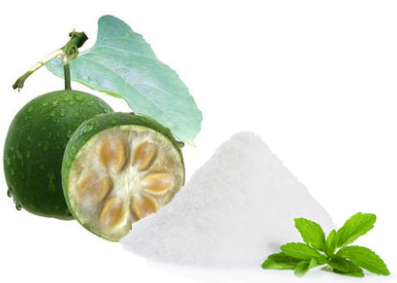Sweeteners
There is a marked uptick in the consumption of nonnutritive sweeteners (NNS) in both foods and beverages in the recent years due to the heightened desire for health and nutrition, enhanced palatability, “sugar-free” label, and the comparatively low cost of NNS related to nutritive sweeteners.
With continued escalating rates of obesity, diabetes, and other related comorbidities, in combination with global public policies calling for modifications in sugar consumption, and no- or at least low- calorie sweeteners such as stevia and Monk fruit are increasing in popularity and enthusiasm among food companies and shoppers (Samuel, Ayoob, Magnuson, Wölwer-Rieck, Jeppesen, Rogers & Mathews, 2018). Processed foods and sugary soda still contain high quantities of refined sugar.
Steviol glycoside sweeteners are derived and filtered from the Stevia rebaudiana Bertoni plant, a member of the Asteraceae family is indigenous to South America. It has been used there for centuries because of its sugary characteristics.
The all-natural herbal “sweet herb” (El Caa-ehe) employed by the Guaraní tribes dwelling in the forests of today’s eastern Paraguay and southern Brazil, is quickly appearing as natural sweetener alternative both to sugar and synthetic sweeteners, well beyond Japan where it is widely used since the mid 1970s (Ciriminna, Meneguzzo, Pecoraino, & Pagliaro, 2018). Sweeteners from Stevia extracts, available on the marketplace in powder, tablet, and liquid form, today are widely used to sweeten a variety of beverage and food products.
Monk fruit is native to China, and it has been used as a common sweetening substitute for many centuries among Asians (Tey, Salleh, Henry & Forde, 2017). The consumption of monk fruit has been shown to exhibit antihyperglycaemic effect by stimulating insulin secretion. Substituting nutritive sweetener with non-nutritive sweeteners has the capacity to enhance glycaemic restriction (Tey, Salleh, Henry & Forde, 2017).
 source: Google
source: Google
Interventions such as restricting consumption of supplemented sugar or replacing nutritive sweetener with nonnutritive sweeteners have the potential to decrease energy intake and to check and manage diabetes. According to Stewart, the newest addition to the alternative sugar market is sugar alcohols and although they cause a slow increase in blood sugar a downside is intestinal distress (Stewart, 2007).
By reading labels, a consumer will instantly understand just how frequently sugar is added to foods when you look for it. Now that you know which constituents to look for don’t quite there. Buyers must infer the presence of added sugar by studying food labels and recognizing when it comes to ingredient lists, "sugar" isn't the only name sugar goes by.
There are more than 60 various names for sugar including the infamous high fructose corn syrup (HFCS), brown rice syrup, agave, and sucrose—that are used to signify that sugar has been added to a commodity (Vanderlee, White, Bordes, Hobin & Hammond, 2015). Added sugar shows up in various prepared foods and snacks, and abandoning those foods along with sugar can make a significant difference.
References:
Ciriminna, R., Meneguzzo, F., Pecoraino, M., & Pagliaro, M. (2018). A bioeconomy perspective for natural sweetener Stevia. AgriXiv. August, 22.
Samuel, P., Ayoob, K. T., Magnuson, B. A., Wölwer-Rieck, U., Jeppesen, P. B., Rogers, P. J., ... & Mathews, R. (2018). Stevia Leaf to Stevia Sweetener: Exploring Its Science, Benefits, and Future Potential. The Journal of nutrition, 148(7), 1186S-1205S.
Stewart, K. L. (2007). Eating Between the Lines: The Supermarket Shopper's Guide to the Truth Behind Food Labels. Macmillan.
Tey, S. L., Salleh, N. B., Henry, J., & Forde, C. G. (2017). Effects of aspartame-, monk fruit-, stevia-and sucrose-sweetened beverages on postprandial glucose, insulin and energy intake. International Journal of Obesity, 41(3), 450.
Tey, S. L., Salleh, N. B., Henry, C. J., & Forde, C. G. (2017). Effects of non-nutritive (artificial vs natural) sweeteners on 24-h glucose profiles. European journal of clinical nutrition, 71(9), 1129.
Vanderlee, L., White, C. M., Bordes, I., Hobin, E. P., & Hammond, D. (2015). The efficacy of sugar labeling formats: Implications for labeling policy. Obesity, 23(12), 2406-2413.
Thanks to everyone that took time to read my First post. Please let me know any tips to make it better. I tend to want to make sure the reader has a lot of references to do independent research. I completed an MS in Complementary Alternative Medicine with concentrations in holistic nutrition and herbalism from American College of Healthcare Science (ACHS) as well as in my final semester in my Master of Science in Holistic Nutrition from ACHS. Here is my bio https://www.voodewnutrition.com/my-bio
Anyway thank you all!!